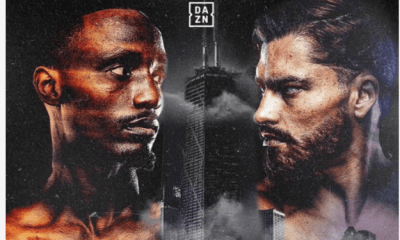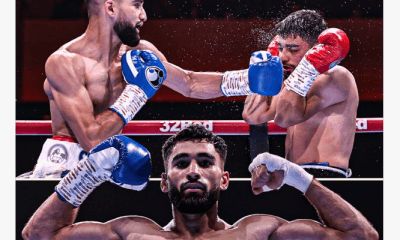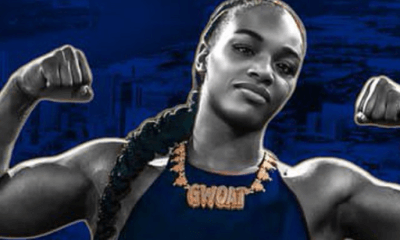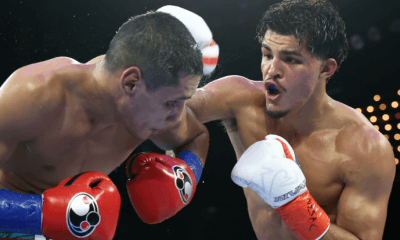Asia & Oceania
The 50 Greatest Welterweights of all Time. Part One: 50-41
50 Greatest Welterweights – I was surprised to find that the welterweights were not as stacked as the middleweights. There was a squabble among around twenty fighters for the eight spots between fifty and forty-three and the sense that there was a “truth” to my eventual selections is absent. The bottom eight presented here could easily be comprised of eight different fighters as it was the narrowest slivers that separated these men from the fighters who didn’t make it, and smaller differences that separate them from each other. Looking now at numbers forty-nine and fifty, I know that Gaspar Ortega and Don Jordan probably have as strong a case as Simon Brown and Ike Quartey.
So conclusion one is that the middleweight division is deeper than the welterweight division, but it is also true that at no time during this project, which has seen ATG lists produced for light-heavyweight and heavyweight as well as middleweight, have I had so much fun crunching footage. Watching the welterweights has been sheer joy. Breaking down a fighter’s career on film can become a chore because not all fights are equally entertaining and many are being re-visited, but watching the great welterweights has been a deep joy from beginning to end. So although, in a sense, welterweight compares negatively to middleweight, in another it compares mightily – and unquestionably runs deeper than light-heavyweight.
The boring stuff: this is not a head to head list. This is a composite list which tries to draw influences from all the traditional criteria for ranking of which head to head is only a small part. Achievements, defenses of the legitimate title, dominance over opposition or even an era, opposition bested, longevity, troubling losses and skillset on film are all more important to me than the imagined outcome of fights between fighters who never met. This has to be the case when comparing fighters who fought more than 100 years apart and in considering fighters who I have never seen box. In these instances, reading replaces watching as we try to piece together the careers of fighters who fought in a more shadowy ring than the one under the blazing lights of the color television era.
With that out of the way…
…this, is how I have them:
#50 – Simon Brown (47-12)
Simon Brown’s competition for the #50 spot was deep and varied. Fighters considered for the low spot on the high mountain included two-time champion Matty Matthews, his storied contemporary, Honey Melody, the mercurial Ceferino Garcia and unlucky #51, Tony DeMarco. The inconsistency of these men let Brown slip in the back door to the top fifty, a door he now minds as the gatekeeper to history.
Beaten twelve times in his career, Brown lost only twice at the 147lb weight limit, to the wonderful Marlon Starling, having boxed barely twenty fights, and to the superb Buddy McGirt in the fight that signaled the end of his title reign and of his time in the welterweight division. Humble, pious, respectful and concentrated outside the ring, Brown verged on the legitimately menacing inside it, a stalker who exhibited a savagery that often transgressed the bounds of what is acceptable in the ring, a thumping pressure-fighter who became legitimately frightening when he smelled blood.
He picked up an alphabet strap for the first time early in 1988, taking on the capable Tyrone Trice for the trinket in question. Trice had as much heart as can be crushed into a 147lb frame although he had more room than most to spread that poundage, being a welterweight of large dimensions. Both men took to the pocket early to attempt to dominate one another but it was the bigger Trice who forced Brown back – but this is important to note. Brown was not a one-trick pony; he went on the move after Trice dropped him with a left-hook and a bowling-ball right landed up above the ear in the second. Brown bided his time, finally won a round in the sixth, and never looked back. By the thirteenth, Trice was drunkenly staggering around the ring looking for the exit and in the fourteenth it was deemed the judges would not be needed. Their rematch was a one-sided brutalization.
Brown defended that strap on numerous occasions, but far more important was his general standing within his division during that time. He was ranked by Ring as one of the six best welterweights in the world for an outstanding eight consecutive years. By the time of his 1991 meeting with one of his closest friends, Maurice Blocker, he was probably past his very best but this fight, depending upon your point of view, was either a battle to crown a new lineal welterweight champion or an alphabet unification bout. Whatever the details, Blocker had the long jab and intelligence to trouble Brown and did; Brown found him, whilst behind on the cards, in the twelfth but eschewed all notes of triumph until he had consoled his friend, whom he broke in the tenth.
Former world champion Jorge Vaca was yo-yoed off the canvas like a journeyman in 1988 and there ends the significant portion of Brown’s ledger. A gifted body-puncher with a fantastic chin, superb infighting ability both on offense and defense, he also had a quality engine. Bordering upon the monstrous over the fifteen round distance, he was nevertheless an excellent twelve round fighter and although his inclusion here can be argued, as can the last name on almost any list, I think he’s good for it.
#49 – Ike Quartey (37-4-1)
Heavy-handed, disciplined and armed with a priceless and unerring accuracy, Ike Quartey, out of Ghana, was a handful for anyone, as he proved in stretching the unbeaten Oscar De La Hoya to the absolute limit in 1999, arguably having slipped past his own prime. This fight was Quartey’s date with destiny and he failed, by a hair’s breadth, both on my scorecard (I had it 114-113, De La Hoya triumphing by virtue of a twelfth round knockdown) and on the judge’s, where he dropped a split decision. Nevertheless, it is not difficult to find fight fans who believe De La Hoya was lucky to be awarded this decision; suffice to say that Quartey’s career would have been very different had he edged this one.
His best performance, the one that most defines him for me, was his eleventh round knockout of Crisanto Espana from five years earlier, a fight in which he picked up his alphabet strap. 30-0 when he made his date with Quartey, Espana has become severely underrated since his mid-nineties pomp, when his combination of work-rate, aggression and self-control made him a formidable opponent. So formidable that when the eleventh began, and Quartey put Espana on the slab, I had the Venezuelan ahead; a crafty and capable boxer, Quartey’s insistence and power made those cards redundant with impressive and sudden violence. It is a fight worth seeing.
A foul-filled battle with Oba Carr, oddly rendered a split-decision in a fight I thought Quartey won clearly and a raucous knockout of the dangled Vince Phillips, a true showcase of accuracy in the finish, were other fine highlights of a fine career that perhaps wasn’t all it could have been.
#48 – James McGirt (73-6-1)
Buddy McGirt’s wider resume is rather good but his 19-2 at welterweight was less than overwhelming with a lot of filler and few ranked fighters. He sneaks in here in the main by virtue of his wonderful 1991 win over Simon Brown, who ranks at #50. This was an absolute masterclass against an opponent used to steaming down the straight but who was instead firmly mastered in those later rounds based upon the surety of McGirt in his own stamina, a surety born of discipline. McGirt was able to take all opportunities to punch against Brown that he could see and many that he engineered, including a sizzling right-uppercut left hook combination that really he had no business landing against a quality opponent. McGirt made Brown gun shy, a phenomenal achievement, then he knocked him down and took his title in a near whitewash (I gave Brown two rounds).
The second defense of that title against Mexican banger Genaro Leon was another masterclass (at least until the tired, ragged twelfth), all the more impressive due to McGirt having damaged his left shoulder in training, hampering his best punch, the left hook – but it is for his losses to Pernell Whitaker that McGirt will be most fondly remembered. Losses rarely enhance a fighter’s standing in my eye but the first Whitaker fight was probably an exception; McGirt went in without that wonderful left hook due to the injury to his shoulder that bothered him against Leon and although Whitaker eventually solved and dominated him, he out-boxed the great Sweet Pea early with technically sure in-fighting.
Some will want to see McGirt higher and I understand why. At his best, he was brilliant. But his matchmaking was uninspired in the extreme. He crossed paths with very few top welterweights and although his first fight with Whitaker was an incredible effort, the second was a one-sided thrashing. Mythical factors might drive McGirt up the list a little but in terms of what he actually did, he probably doesn’t belong among The Fifty – the way he did it gets him just inside the line.
#47 – Benny Paret (35-12-5)
Too inconsistent to rank any higher, Benny Paret’s tragically short career was heavily sprinkled with losses and draws, but he nevertheless represents a step up from the level at which McGirt’s competition maroons him. He met an extraordinary run of competition beginning in 1959 with the first of his two back-to-back duels with top contender Charley Scott.
Scott, a lithe and compact technician capable of both the sublime and the ridiculous, stood a heavy favorite over Paret; even after Paret out-classed and dropped him he was made a 3-1 dog in their second fight forty-two days later. Paret dished out another beating only to have the experienced Luis Federico Thompson thrown down between him and a title shot; a drawn contest in which Paret likely deserved the barest of nods was the result, a result Paret converted into a win in their rematch. By that time, he was the world welterweight champion having ripped the title from Don Jordan, an inconsistent king who was ready to be taken. Paret did so utilizing fast, busy hands and quick, organized footwork to get down the straight and scoop up the title after fifteen.
Even then, in his peripheral vision, Paret might have caught sight of the great Emile Griffith who now began to stalk Paret and his title with tragic consequences. The two met for the first time on the occasion of Paret’s second title defense in April of 1961 in a crowded, unsatisfactory affair that was poised evenly at the bell for the thirteenth round, whereupon Griffith found a rare and deadly combination to end the affair. Some hearts are not for breaking though, and Paret came again in September of that same year and took back his title, winning a split after fifteen.
Paret, possibly, did not deserve this decision. It was a wonderful fight of ebbs and flows and Paret showed bravery and quick hands and a quicker mind in the middle rounds to steal those frames and at least give the judges a reason to find for him. Would that the judges had found against him; Paret’s victory meant a rubber match became necessary and in that third contest, Griffith killed Paret in the ring with his punches.
More famous for being beaten to death on live television than anything he did in his mercurial career, there were the bones of a great fighter here who deserves recognition as something more than just boxing’s most famous corpse.
#46 – Vernon Forrest (41-3)
Vernon Forrest earned the #46 spot basically by besting one man on two separate occasions, the then pound-for-pound #1 and world welterweight champion Shane Mosley. Mosley was courting, when he met with the unassuming, unheralded Forrest for the first time, justification of his adoption of the nickname “Sugar.”
Forrest undid that prospect and in the first fight he did it in so dominant fashion that it led to Forrest himself being labelled one of the best fighters in the world, summiting at #3 on Ring’s pound-for-pound list. As is so often the case, Forrest was lauded for his offense in a winning effort but it was a defensive punch, the right uppercut employed when Mosley gained the inside, which was often crucial. Clinching played its part too, as it did in the rematch, won more narrowly on the cards than the first fight but won nonetheless.
Solid and unspectacular, Forrest’s limitations were exposed by the marauding Ricardo Mayorga who blasted him from the pound-for-pound list in three rounds in their first fight and narrowly out-pointed him in their second. Balance disrupted and apparently intimidated, Forrest looked anything but a fighter who belongs on an all-time list of whatever length, but the status of his victim on the two best nights of his career nudge him in ahead of more assured looking performers.
The 50 Greatest Welterweights of all Time. Part One: 50-41
#45 – Jack Carroll (85-11-4)
It is probable that even some hardcore Sweet Science readers will not have heard of Jack Carroll, despite an astonishing thirty fight unbeaten streak that stretched from 1932 to 1938; on the other hand, there will be a small kernel of readership denouncing me for ranking him this low. Carroll was an Australian who never left his home continent and so has been abandoned slightly by a history written mainly by America.
Carroll’s style was the very definition of ugly, encompassing cuffing, slapping and lacing but he also had an intuitive grip of the angles of pugilism and a floaty, whipping left. His crab-like ringcraft led to comparisons with Bob Fitzsimmons but that comparison was born of style alone; Carroll’s left was more hummingbird than scythe and he was not much more dangerous with his right. But he was terribly difficult to catch clean and adept at piling up points.
Despite the oddities of his execution, Carroll is likely the most beloved boxer in the history of his country’s considerable pugilistic history. Tens of thousands turned up to watch him improvise his way through the best imported fighters that money could buy, and although this never included champion Barney Ross, Carroll probably established himself as one of Ross’s finest contenders in beating ranked men like Jimmy Leto (three times), Izzy Jannazzo, Bep Van Klaveren (twice), Jack Portney and Willard Brown.
One might argue that Carroll should have left Australia for Britain and then America but Carroll knew his limitations. He retired, apparently upon medical advice and “on the verge of a nervous breakdown.” Home was where he remained, financially secure, professional satisfied and the hero of his countrymen.
#44 – Joe Dundee (86-22-11; Newspaper Decisions 6-1-1)
Joe Dundee was not a great champion. Although he held the title for just over two years between 1927 and 1929 before losing it to Jackie Fields on a disqualification, in that time he fought a single dubious defense and lost numerous non-title matches.
What scrambles Dundee over the line and onto the top fifty where so many champions with similarly questionable reigns do not is his pre-title run. Moving up from lightweight, he burgled title contendership from Jack McVey, Tommy Freeman and finally Willie Harmon all within the first five busy months of 1926. It was a narrow thing against Harmon who somewhat neutralized Dundee’s offense early before the Baltimore lad, who had been born in Italy, burst open in the final four rounds of their ten round contest. This was typical of Dundee who enjoyed no extraordinary physical attributes outside of his engine, which ground out victories born of a steeltrap mind and a focus of purpose.
He successfully stalked and even stopped one Mickey Walker, too, just days after that victory over Harmon. The great Walker carried an old wound to the ring and Dundee capitalized mercilessly, the referee stopping the fight in the eighth with the former champion “practically blinded” by blood according to the Universal Service. Dundee dominated that fight, losing perhaps only the first round and while the temptation is to name Walker past-prime, it is worth noticing that the “Toy Bulldog” still had the middleweight and light-heavyweight championship of the world in his future.
Dundee won his title shot over Pete Latzo at a canter, although one judge somehow found a draw, rendering it a majority decision. In truth, Dundee had outclassed the incumbent champion with pressure and work without fanfare or drama. So began his ignoble reign, barracked by the old fashioned grit that saw him rise to the top.
#43 Dave Shade (132-28-59; Newspaper Decisions 24-1-1)
Dave Shade turned professional at the end of World War One and boxed all the way to the cusp of World War Two, and for the entirety of his career he was matched hard and often – the man lived to be eighty-one years old. He had the innate toughness of the inanimate but in the ring preferred the rule of perpetual motion to that of inertia, bobbing, weaving, and boring in.
Shade’s wonderful durability, fine jab, and slippery inward trajectory made him a force against even light-heavyweights, but it was at 147lbs that he came nearest to making his championship mark, twice holding veteran welterweight demi-god Jack Britton to a draw. He was lucky, perhaps, to gain the second but may have been unlucky not to have received more from the first after dropping the demi-god sharply on his behind and pressing him all the way.
Shade himself identified not those desperate draws with Britton as his toughest, however, but rather his three encounters with the toy bulldog, Mickey Walker. One can imagine that it would be reasonable for Shade simply to curse his luck at finding himself strapped between the reigns of first Britton and then Walker but Shade, instead, got on with the job of trying to beat the man – and he did just that.
Shade lost his first 1921 encounter with Walker when he was forced to retire with a hand injury but took the newspaper decision when the two met in a rematch four weeks later. When Walker successfully dethroned Britton, Shade was a natural for a shot at the title, but it was Walker who took the controversial split-decision victory.
Shade had a way of reaching into the jeweler’s purse and coming up with a turd, as was the case when he met with Jimmy Jones in defense of the alphabet belt he was awarded in the boardroom for all that he couldn’t gain one in the ring, unexpectedly losing despite twice dropping Jones in the early rounds. In a way it summarized a career of one of the division’s great nearly men.
#42 – Paddy Duffy (33-3-21)
Paddy Duffy is generally credited as being the first welterweight champion. He claimed the title in earnest in 1888 after his one-sided destruction of teak-tough Scotsman Billy McMillan, Britain’s premier welterweight, who he handled with no great tenderness for a total of seventeen rounds. A “soft glove” match with Charles Gleason became his first defense by default when the Englishman gave the champion a fright in what was little more than an exhibition – but this confrontation was dwarfed by the epic forty-five round war Duffy staged with contender Tom Meadows in 1889.
Meadows, out of Sydney, Australia, had rocked his way through the best his country had to offer and had remained undefeated throughout his 1888 campaign in America. He boxed cautiously early against Duffy, trying to take the sting out of the champion’s rushes by boxing and moving but he found himself up against it in his commitment to this strategy; Duffy was relentless as the tide, storming the Meadows barricade and drawing blood from his ear as early as the second. Speed of pressure seemed Duffy’s greatest weapon and he reportedly came close to dropping his foe in the third with a left, his more prestigious appendage. It was the twelfth, however, before Meadows felt safe enough to stand his ground and fight. By the 24th the heat had been drawn from the fight by a foggy balm, but Duffy, as he always did in his prime, proved the harder man. At bottom, it was that simple for him – he outlasted and out-gamed the sheetrock tough Australian and by the end of the fight was sending him to the canvas with sickening regularity.
Meadows fouled out, launching himself bodily at his tormentor, disqualified for head butts as the two tangled on the canvas.
Tragically, Duffy was claimed by tuberculosis the following year, aged just twenty-five and in his absolute prime. One imagines his inability to out-last even this terrible foe came as something of a surprise.
#41 – Young Jack Thompson (79-31-10)
To say that Jack Thompson has been handed the benefit of the doubt by history is hardly to stretch a point. Named “one of the finest performers the ring has ever known” by Nat Fleischer, Cyber Boxing Zone bemoans the “outright robberies” he suffered in explaining some of his thirty-one losses. They name, in particular, his “highly controversial” ten round non-title fight defeat to Lou Brouillard as being questionable. This is nonsense; the decision was just. The Associated Press noted that Brouillard defeated Thompson by “a wide margin” and that he was “much too strong” for Thompson; indeed, in the rematch a few months later for the welterweight championship, Brouillard thrashed him. Thompson’s status as victim has, probably based upon Nat Fleischer’s admiration for him, been exaggerated.
There were questionable decisions – such as his ten round loss to the great Jimmy McLarnin, a fight that probably could have gone either way (many ringsiders gave it to Thompson, but there are cards for McLarnin, who broke his hand in the first round), but then there was his handy defeat by Bucky Lawless, a fight in which he was protected from the loss of his title by his insistence that Lawless come in a pound over the championship weight. There are swings and roundabouts in Thompson’s career, one that is rather typical of a mercurial talent unable to equalize his brilliance with consistency. Sure, there were decisions he perhaps should have received – including a crucial one – but not 31 of them.
For all that, Thompson was a man of true significance in the welterweight picture of the 1920s and early 1930s. He came to real prominence in destroying reigning welterweight champion Joe Dundee in a non-title fight, obliterating him in just two rounds. After some more impressive wins he ran into Jackie Fields who twice defeated him before he took his revenge in a title match in May 1930, a brilliant, dominant performance by Thompson over a great champion. But he dropped the title in his first defense, to the scrapper Tommy Freeman in a probable robbery, the most significant and unquestioned “questionable decision” of his career; Thompson reclaimed the title a few weeks later in a brutal battering of the same man.
There were other good nights and other bad, including his third loss to Young Corbett III who cleanly defeated Thompson twice (their first fight possibly should have been scored a draw). A very fine fighter, and legitimately among the top fifty of this division’s rich history, neither the historical standing foisted upon him by Fleischer, or his “honorable mention” for the IBRO top twenty welterweights of all time sits particularly well with me.
Check out the latest news and videos at The Boxing Channel
-

 Featured Articles3 weeks ago
Featured Articles3 weeks agoResults and Recaps from New York Where Taylor Edged Serrano Once Again
-

 Featured Articles5 days ago
Featured Articles5 days agoThe Hauser Report: Zayas-Garcia, Pacquiao, Usyk, and the NYSAC
-

 Featured Articles3 weeks ago
Featured Articles3 weeks agoResults and Recaps from NYC where Hamzah Sheeraz was Spectacular
-

 Featured Articles4 weeks ago
Featured Articles4 weeks agoFrom a Sympathetic Figure to a Pariah: The Travails of Julio Cesar Chavez Jr
-
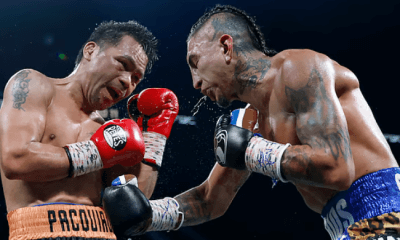
 Featured Articles2 weeks ago
Featured Articles2 weeks agoManny Pacquiao and Mario Barrios Fight to a Draw; Fundora stops Tim Tszyu
-

 Featured Articles3 weeks ago
Featured Articles3 weeks agoPhiladelphia Welterweight Gil Turner, a Phenom, Now Rests in an Unmarked Grave
-
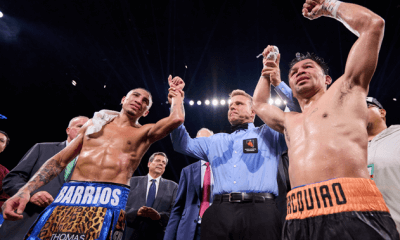
 Featured Articles2 weeks ago
Featured Articles2 weeks agoArne’s Almanac: Pacquiao-Barrios Redux
-

 Featured Articles4 weeks ago
Featured Articles4 weeks agoCatterall vs Eubank Ends Prematurely; Catterall Wins a Technical Decision


